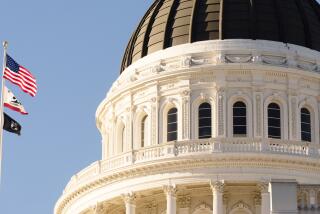A budget California can afford
California’s fortunes have improved so dramatically in the last two years, it was hard for even Gov. Jerry “Era of Limits” Brown to sound dour about the government’s finances when he rolled out his $155-billion budget proposal last week. The tax increases that Brown persuaded voters to approve in November 2012 have not only averted the need to slash more from education and other state programs, they’ve helped generate a multibillion-dollar surplus. Yet Brown has stuck with the cautious practices that led the state safely to this point, proposing to pay down debt and focus new spending on education rather than trying to undo all the cuts the Legislature made during the downturn. As hard as the reductions have been for some vital state programs, Brown is right to stay the course.
The state has reached an awkward point in its slow recovery from the recession. Although unemployment and poverty rates — 8.5% and 16%, respectively — remain well above their pre-recession levels, the government’s fiscal picture has brightened at a significantly faster pace. That’s largely because so much of its revenue comes from taxes on households with high incomes, which have fared better than analysts projected. The long-running bull market has been particularly helpful, causing an extended surge in capital gains tax payments.
It’s foolish to count on Wall Street to keep the party going year after year, however. With that in mind, Brown has proposed only modest increases in ongoing programs, undoing just a few of the worst cuts to the safety net. Instead, he wants to use surplus dollars mainly to repair some of the fiscal damage caused by budget gimmicks and stopgap measures over the last decade. That means paying back billions borrowed from schools, investors and special funds. He also would make a $1.6-billion down payment on a reserve fund large enough to weather the inevitable next downturn.
The governor’s proposal is merely his opening bid in the budget process, and legislative Democrats will probably push him to spend a greater share of the surplus on more tangible programs and services. It may be wise to use some of those dollars to reverse penny-wise, pound-foolish cuts made in the years of multibillion-dollar deficits. But paying down debt should remain a top priority, because it’s a one-time expense that bears repeated dividends in later years, saving money the state otherwise would have to pour down the debt-service drain.
The “wall of debt” that Brown has been targeting is just one of the fiscal hurdles the state must overcome. Still waiting to be addressed are an estimated $218 billion in unfunded pension and retiree healthcare benefits, nearly $9 billion in liabilities for unemployment benefits and more than $64 billion in deferred maintenance projects. Those realities should temper the ambitions of lawmakers eager to spend more or tax less. The state is clearly on better fiscal footing, but it’s still carrying too much weight.
More to Read
A cure for the common opinion
Get thought-provoking perspectives with our weekly newsletter.
You may occasionally receive promotional content from the Los Angeles Times.










